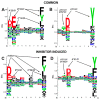ERAP2 Inhibition Induces Cell-Surface Presentation by MOLT-4 Leukemia Cancer Cells of Many Novel and Potentially Antigenic Peptides
- PMID: 35163832
- PMCID: PMC8836666
- DOI: 10.3390/ijms23031913
ERAP2 Inhibition Induces Cell-Surface Presentation by MOLT-4 Leukemia Cancer Cells of Many Novel and Potentially Antigenic Peptides
Abstract
Recent studies have linked the activity of ER aminopeptidase 2 (ERAP2) to increased efficacy of immune-checkpoint inhibitor cancer immunotherapy, suggesting that pharmacological inhibition of ERAP2 could have important therapeutic implications. To explore the effects of ERAP2 inhibition on the immunopeptidome of cancer cells, we treated MOLT-4 T lymphoblast leukemia cells with a recently developed selective ERAP2 inhibitor, isolated Major Histocompatibility class I molecules (MHCI), and sequenced bound peptides by liquid chromatography tandem mass spectrometry. Inhibitor treatment induced significant shifts on the immunopeptidome so that more than 20% of detected peptides were either novel or significantly upregulated. Most of the inhibitor-induced peptides were 9mers and had sequence motifs and predicted affinity consistent with being optimal ligands for at least one of the MHCI alleles carried by MOLT-4 cells. Such inhibitor-induced peptides could serve as triggers for novel cytotoxic responses against cancer cells and synergize with the therapeutic effect of immune-checkpoint inhibitors.
Keywords: adaptive immunity; aminopeptidase; antigen presentation; antigenic peptide; immunopeptidome; inhibitor; major histocompatibility molecules; proteomics.
Conflict of interest statement
The authors declare that they have no competing financial interest.
Figures





Similar articles
-
Editing the immunopeptidome of melanoma cells using a potent inhibitor of endoplasmic reticulum aminopeptidase 1 (ERAP1).Cancer Immunol Immunother. 2019 Aug;68(8):1245-1261. doi: 10.1007/s00262-019-02358-0. Epub 2019 Jun 20. Cancer Immunol Immunother. 2019. PMID: 31222486 Free PMC article.
-
Rationally designed inhibitor targeting antigen-trimming aminopeptidases enhances antigen presentation and cytotoxic T-cell responses.Proc Natl Acad Sci U S A. 2013 Dec 3;110(49):19890-5. doi: 10.1073/pnas.1309781110. Epub 2013 Nov 18. Proc Natl Acad Sci U S A. 2013. PMID: 24248368 Free PMC article.
-
Intracellular antigen processing by ERAP2: Molecular mechanism and roles in health and disease.Hum Immunol. 2019 May;80(5):310-317. doi: 10.1016/j.humimm.2018.11.001. Epub 2018 Nov 7. Hum Immunol. 2019. PMID: 30414458 Review.
-
Distinct modulation of cellular immunopeptidome by the allosteric regulatory site of ER aminopeptidase 1.Eur J Immunol. 2023 Aug;53(8):e2350449. doi: 10.1002/eji.202350449. Epub 2023 May 15. Eur J Immunol. 2023. PMID: 37134263
-
Molecular pathways for antigenic peptide generation by ER aminopeptidase 1.Mol Immunol. 2019 Sep;113:50-57. doi: 10.1016/j.molimm.2018.03.026. Epub 2018 Apr 17. Mol Immunol. 2019. PMID: 29678301 Free PMC article. Review.
Cited by
-
ERAP Inhibitors in Autoimmunity and Immuno-Oncology: Medicinal Chemistry Insights.J Med Chem. 2024 Jul 25;67(14):11597-11621. doi: 10.1021/acs.jmedchem.4c00840. Epub 2024 Jul 16. J Med Chem. 2024. PMID: 39011823 Free PMC article. Review.
-
Phosphinic Peptides as Tool Compounds for the Study of Pharmacologically Relevant Zn-Metalloproteases.ACS Pharmacol Transl Sci. 2022 Nov 28;5(12):1228-1253. doi: 10.1021/acsptsci.2c00183. eCollection 2022 Dec 9. ACS Pharmacol Transl Sci. 2022. PMID: 36524013 Free PMC article. Review.
-
Impact of endoplasmic reticulum aminopeptidases 1 (ERAP1) and 2 (ERAP2) on neutrophil cellular functions.Front Cell Dev Biol. 2025 Jan 7;12:1506216. doi: 10.3389/fcell.2024.1506216. eCollection 2024. Front Cell Dev Biol. 2025. PMID: 39839670 Free PMC article.
-
Targeting the antigen processing and presentation pathway to overcome resistance to immune checkpoint therapy.Front Immunol. 2022 Jul 22;13:948297. doi: 10.3389/fimmu.2022.948297. eCollection 2022. Front Immunol. 2022. PMID: 35936007 Free PMC article. Review.
-
Unveiling the impact of ERAP1 and ERAP2 on migration, angiogenesis and ER stress response.Front Cell Dev Biol. 2025 Mar 28;13:1564649. doi: 10.3389/fcell.2025.1564649. eCollection 2025. Front Cell Dev Biol. 2025. PMID: 40226591 Free PMC article. Review.
References
MeSH terms
Substances
Grants and funding
LinkOut - more resources
Full Text Sources
Medical
Molecular Biology Databases

